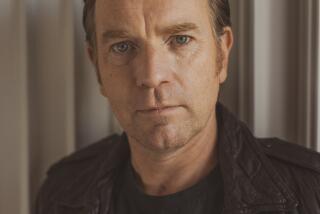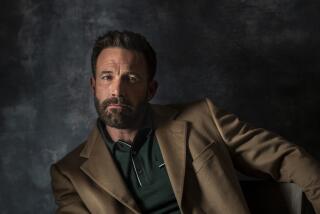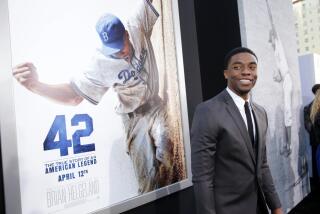What drove John McEnroe’s greatness and rage? A new doc tries to find out
John McEnroe played his last professional singles match in 1994, but in the intervening decades the tennis star has grown into a kind of legend and an enduring part of pop culture.
The talented, volatile McEnroe has been spotlighted in the HBO documentary “McEnroe/Borg: Fire & Ice.” He’s been dramatized by Shia LaBeouf in “Borg vs. McEnroe.” Then there were the repeated appearances as himself in Adam Sandler films and on “30 Rock,” plus talking head interviews in docs about everything from Venus and Serena Williams to conceptual artist Chris Burden.
But the new documentary “John McEnroe: In the Realm of Perfection,” which opens Friday in Los Angeles, examines him as a player and a person in a way that no other film has done before. Actually, it’s hard to recall if there’s ever been any sports documentary like “In the Realm” before.
That reality becomes apparent in its opening credits sequence, which features an entrancing montage of McEnroe tossing serves in slow motion, set to Sonic Youth’s distorted blastoff “The Sprawl.”
Befitting a movie as unexpected as “In the Realm” is its unexpected origin story. Director Julien Faraut is a civil servant in France who manages the film collection at the National Institute of Sport. A friend of his was making a documentary about Gil de Kermadec, a former national technical director of the French Tennis Federation who created instructional films about the sport.
The son of an abstract painter and friends with filmmakers like Michelangelo Antonioni, De Kermadec decided in the mid-1970s that the best way to capture the reality of the game was to choose a single player to follow throughout the French Open, also known as Roland-Garros. In each match he would train multiple film cameras on that player, paying no attention to the opponent, the score or the eventual outcome.
The purpose was to study the physical performance of that player in the moment, at his or her peak and under pressure. His final exploration was filmed in 1984, and the subject was McEnroe. When Faraut went through the archives he found the hours and hours of raw footage that De Kermadec had produced.
“In the Realm” is a collage built from this source material, enhanced with elements like narration from actor Mathieu Amalric, audio from Martin Scorsese’s “Raging Bull,” images from the 1984 film “Amadeus” (actor Tom Hulce is said to have based his performance as Mozart on McEnroe), and heady digressions into subjects like how our own perceptions of ourselves differ from what others see.
What we mostly see of McEnroe is from his time on the court in ’84, though there are some glimpses from that era of him practicing with his brother Patrick and looking uncomfortable during a promotional photo shoot. De Kermadec interviewed McEnroe around this time, but Faraut chose not to use any of it since the star spent most of the time looking down at the floor or getting frustrated over the line of questioning.
Faraut did not try to get McEnroe’s participation in the film or seek him to promote it once it was done. In fact, Faraut admits he has no idea how much of the film McEnroe has seen.
The director has called “In the Realm” a “hip-hop film,” in part because he created no new footage in the making of it.
“Basically I worked with film that had been shot from others, the same way in which musicians work with music that came from others,” he says over the phone, through a translator. “For me, it was almost as if I had found some forgotten tapes or unknown tapes of some of the great groups from the ’70s, and I wanted to sample them.”
Faraut says he’s become frustrated with modern sports documentaries, which may be informative but do little in terms of innovation. Swelling strings and grandiose narration might indicate to a viewer that what they are watching is important, or at least dramatic, but they’ve become such expected conventions that they no longer feel actually cinematic.
Julian created something that grabs you, and it lulls you into its process. It’s going to take you some weird places, and that’s totally cool.
— Dan Berger, President of Oscilloscope Laboratories
“Julian created something that grabs you, and it lulls you into its process,” says Dan Berger, the president of Oscilloscope Laboratories, the company releasing the film. “It’s going to take you some weird places, and that’s totally cool. When you put the ideas of this film down onto a piece of paper and you look at what it’s composed of and some of the things he pulled from and the things he’s telling you, there’s a million ways it can go wrong.”
Among the De Kermadec archives, there was similarly extensive material available for other players of that era that Faraut could have pursued, like Jimmy Connors or Chris Evert. Faraut says McEnroe is the only one he would have made a film about, largely because of how misunderstood of a figure he thinks he is. These days McEnroe is often remembered as being an impetuous brat on the court. His outbursts have come to largely define him in the public imagination. Faraut does not shy from this aspect of his play, sometimes following his arguments with chair umpires and even De Kermadec’s film crew for excruciatingly long periods.
But in 1984, the year that De Kermadec studied McEnroe at Roland-Garros, he won an astounding 82 of the 85 matches he played. Hence the film’s title. As author David Foster Wallace wrote in Esquire magazine in 1996, “At his peak (say 1980-1984), [McEnroe] was the greatest tennis player who ever lived — the most talented, the most beautiful, the most tormented: a genius. For me, watching McEnroe don a blue polyester blazer and do stiff lame truistic color commentary for TV is like watching Faulkner do a Gap ad.”
“In the Realm” was made in the hopes that this portrayal would help broaden the understanding of McEnroe, making him more than just a punchline to jokes about anger management or sports squabbles.
“A lot of times, because of his antics on the court, he was viewed almost as a comic kind of figure,” Faraut says. “To see people laugh at him, it really made me very angry. So one of my purposes in making this film was I really wanted to have an opportunity to explain to them: This is somebody who was not acting. He was not being a comic. He’s really, in a way, suffering on the court, and I wanted people to be able to see this.”
More to Read
Only good movies
Get the Indie Focus newsletter, Mark Olsen's weekly guide to the world of cinema.
You may occasionally receive promotional content from the Los Angeles Times.










